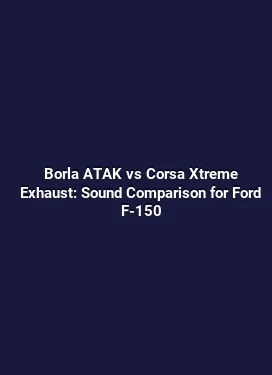Best Slip-On Mufflers for Motorcycle-Inspired Car Exhaust Sound
Understanding Slip-On Mufflers and How They Shape Car Exhaust Tone

Slip-on mufflers are a popular choice for enthusiasts seeking a distinct, motorcycle-inspired exhaust note without a full exhaust system swap. These units hang onto the existing mid-pipe or rear section, often replacing the stock can with a lighter, more resonant chamber. The result is a sonic character that blends deeper growls with sharper, sharper overtones, particularly noticeable at mid to high RPM. Beyond sound, slip-ons can influence exhaust flow, heat management, and weight, factors that subtly alter throttle response and engine feel over time.
When evaluating slip-on options, look for compatibility with the vehicle’s exhaust diameter, mounting style, and hardware included in the kit. Proper fitment is essential not only for achieving the desired tone but also for ensuring gaskets remain sealed and vibration dampening is effective. A well-matched slip-on can reduce unwanted drone at highway speeds, while still delivering a satisfying, aggressive edge when the accelerator is pressed. Real-world testing often reveals that paired with the stock catalytic converter or a compatible cat-back system, the perceived impact on performance and tone can be maximized without triggering excessive resonance.
Key Design Elements That Influence Sound and Perception
Internal Chamber Geometry and Muffler Core

The heart of a slip-on muffler is its core geometry. Straight-through cores tend to deliver a louder, more aggressive tone with increased fuel-through and a higher chance of drone at sustained cruising. Chambered designs, by contrast, use a series of baffles and chambers to shape harmonics, producing a balanced, throaty roar that remains musical across RPM bands. For road-legal use, many manufacturers tune the core to minimize excessive backpressure while preserving the signature growl that characterizes motorcycle-inspired exhausts.
Enthusiasts often compare two main outcomes: louder peak volume and a more defined mid-frequency character. A well-tuned core can yield a crisp snap on throttle tip-in without introducing harsh, piercing highs. It’s also common to find multi-core configurations that separate low-end warmth from higher-frequency brightness, offering a broader listening range that remains pleasant to the ear under varied driving conditions.
Perforation Pattern, Piping Diameter, and Muffler Shape
Perforation patterns dictate how exhaust gases interact with the muffler walls, shaping the exhaust pulse and the perceived tone. A higher perforation density can soften the sound, while wider spacing tends to produce punchier notes with more pronounced crackle. Piping diameter influences backpressure and flow dynamics; matching the stock diameter often preserves engine response, whereas slight increases can elevate tone and fullness without sacrificing drivability.
The external shape—whether cylindrical, oval, or compact canister—affects resonance and the tail-end timbre. Shorter, stubby designs may emphasize higher-frequency presence, whereas longer cans with rounded bodies tend to deliver a deeper, smoother note. Sound is a product of both internal design and how the muffler interacts with the vehicle’s overall exhaust path, including the mid-pipe and catalytic converter configuration.
Popular Models and How They Compare in Real-World Scenarios
Across different vehicle platforms, several slip-on options consistently deliver a motorcycle-inspired cadence with practical benefits. When selecting a model, consider material quality, mounting hardware, weight savings, and warranty support in addition to the audible character. A few well-regarded categories include stainless steel construction for durability, aluminized options for budget-conscious builds, and carbon fiber end caps for a premium aesthetic paired with aggressive acoustics.
Model Families Typically Found on the Market
1) Street-Grade Slip-Ons: Built to provide a balanced tone suitable for daily driving and weekend cruises. They emphasize a confident growl without overwhelming cabin resonance. 2) Track-Style Variants: Prioritize a sharper top-end presence and a louder overall volume, often with lighter weight and a more aggressive exhaust note that ticks upward in pitch as RPM climbs. 3) Heritage-Inspired Designs: Aim to emulate classic motorcycle exhaust timbres, delivering a nostalgic yet contemporary sound profile that pairs well with retro-styled vehicles or modern builds seeking character over brute force.
Real-world testing indicates that the best options deliver a noticeable tonal shift without introducing excessive drone. When installed correctly, these mufflers can partner with the stock exhaust path to preserve sensor integrity, maintain emission compliance in many jurisdictions, and keep the overall vehicle performance within expected tolerances. Home tuners frequently report a satisfying blend of audible presence at idle, a robust mid-range growl under acceleration, and a playful crackle during deceleration, aligning with the motorcycle-inspired dream many car enthusiasts chase.
Installation, Fitment, and Tuning Tips for Optimal Results
Installing slip-on mufflers is typically straightforward, but a few practical steps ensure the best outcome. Begin by verifying fitment with the vehicle’s model year, engine type, and existing exhaust hardware. Some slip-ons include universal clamp systems that adapt to multiple diameters, while others rely on specific hangers or mounting brackets that must be aligned precisely to avoid contact with heat shields or undercarriage components.
Before unboxing, gather essential tools: a torque wrench, jack stands, sealant or gaskets if required, and anti-seize lubricant for bolts. It’s prudent to inspect the exhaust mounting points for wear or corrosion and replace any degraded hardware to maintain a secure, vibration-free connection. When in doubt, consult the muffler’s installation manual or seek guidance from experienced installers who have worked with the same vehicle platform.
During the bolt-up process, ensure proper alignment to prevent rubbing against the chassis or suspension components. A misaligned muffler can alter the exhaust path, causing unwanted noise or heat transfer. After installation, perform a careful system check: start the engine, listen for rattles, verify exhaust leaks, and confirm that there is no interference with moving parts. A short test drive will reveal whether the tone remains consistent across RPM bands and whether any drone emerges at highway speeds. If drone appears, a minor rearrangement of mounting points or a slight change in the muffler position can mitigate it without compromising the intended sound.
Sound Profiles, Realistic Expectations, and How to Compare Options
When evaluating sound profiles, focus on how the exhaust note translates from idle to redline rather than relying solely on peak volume. A well-designed slip-on should deliver a warm, authoritative rumble at low RPM, intensify with throttle input, and maintain a musical cadence as RPM climbs. Drone—notorious at higher speeds—should be manageable or absent at cruising speeds, ensuring comfort for daily use. Listen for tonal balance across frequencies; the goal is a compelling voice that enhances character without creating fatigue for the driver or passengers.
Practical testing involves listening to mufflers in controlled environments or reputable showrooms, and if possible, on the road with varied driving scenarios. Some manufacturers publish sound videos showcasing real-world drive conditions, which can be a helpful reference. It’s also beneficial to compare similar models on the same vehicle to understand how slight design differences translate into audible outcomes. Remember that individual perception plays a role—two mufflers with the same core design may sound subtly different due to mounting geometry and vehicle acoustics.
Legal Considerations, Vehicle Use Scenarios, and Longevity Insights
End-users should be aware that exhaust sound levels can be subject to local noise ordinances and vehicle inspection standards. It’s important to confirm compatibility with emissions equipment and ensure that the muffler configuration does not interfere with oxygen sensors or catalytic converters. When legal compliance is a priority, select models that are designed to minimize negative impacts on emissions systems while still achieving the desired tone. Proper maintenance—such as periodic inspection for rust, gasket integrity, and hanger wear—extends muffler life and preserves sound quality over time.
From a longevity perspective, materials like stainless steel resist corrosion in road salt environments, while carbon fiber end caps offer weight savings and a premium aesthetic without sacrificing durability. The overall lifespan also depends on driving habits: frequent high-RPM driving and aggressive throttle usage can accelerate wear in some slip-on designs, whereas a balanced daily-driving pattern can maximize durability. Clean, consistent maintenance routines help prevent performance degradation and ensure that the exhaust remains responsive and sonically pleasing across the vehicle’s ownership lifecycle.
Practical Considerations for Car Enthusiasts
For enthusiasts pursuing a motorcycle-inspired stance, slip-on mufflers offer a pragmatic bridge between stock comfort and customized personality. They provide a cost-efficient upgrade relative to a full exhaust system while delivering a tangible shift in tone and perceived performance. When selecting a muffler, evaluate the overall vehicle integration: does the kit align with your aesthetic goals, weight targets, and the driving experiences you value most? Considering the balance between cost, weight, and acoustic intent helps in choosing a model that delivers consistent satisfaction over time.
Additionally, consider how your drive style might evolve with a new exhaust sound. A louder, more assertive tone can influence how you perceive throttle response and may encourage more spirited driving. Some drivers notice a subtle shift in how the engine responds to mid-range loads, especially if the muffler’s design affects backpressure. While the changes can be modest, they contribute to a more engaging daily experience and a stronger identity on the road.
Maintenance and Care for Longevity
Regular inspection is key. Check for exhaust leaks around joints and gaskets, ensure clamps remain tight, and look for corrosion on mounting points. Cleaning the exterior with a mild cleaner helps preserve the finish on stainless steel or carbon fiber components. If a muffler develops surface rust, addressing it early with rust-inhibiting treatments can prevent deeper structural issues. Storing or parking away from harsh elements when possible also contributes to longer-term performance and appearance.






